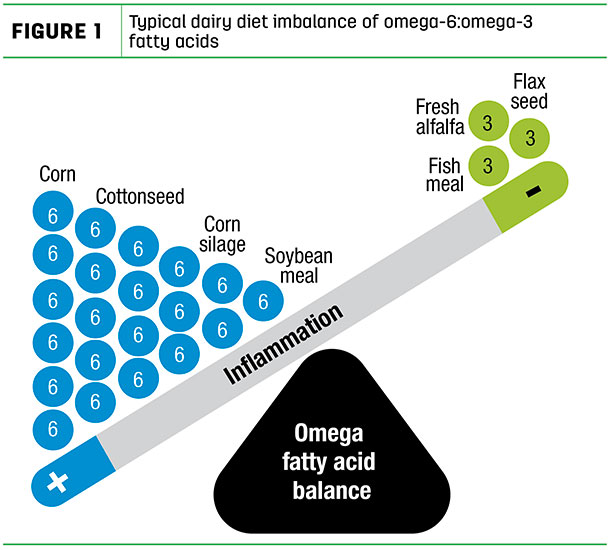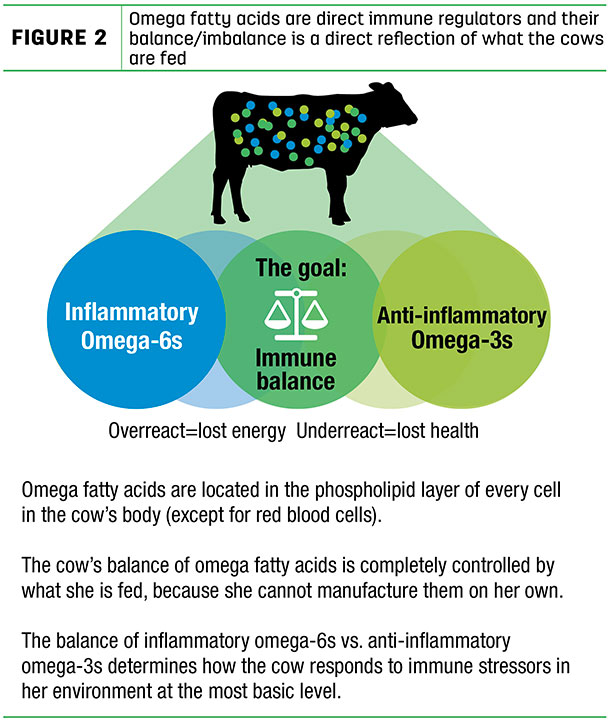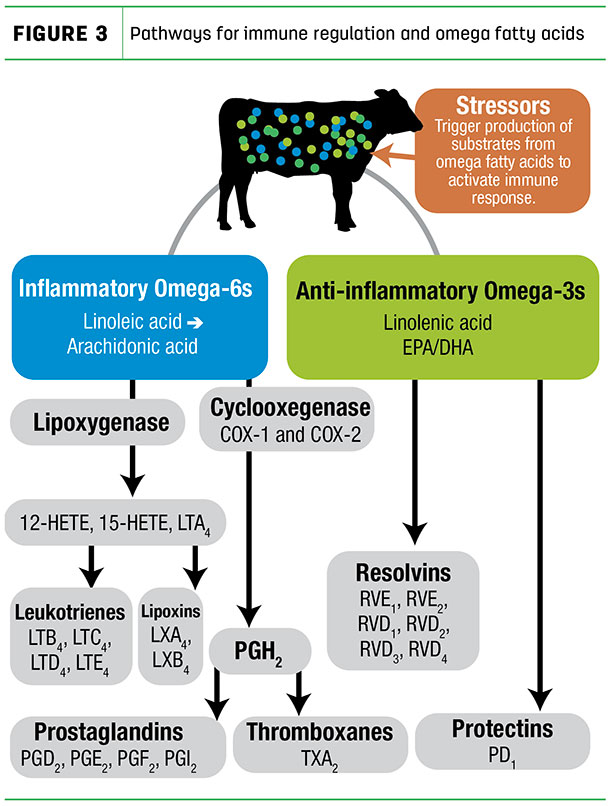Second, producers and nutritionists alike have learned that we can feed specific fatty acids to our herds and improve milk, milkfat, reproduction and immune health.
While energy is typically the first thing that comes to mind regarding the reason to feed fat to dairy cows, there are specific fatty acids called omega-6 and omega-3 fatty acids that play a direct role in immune regulation. Whether you are specifically balancing for omega fatty acids or not, the amount of omega fatty acids fed directly impacts the immune status of your herd.
Where are omega fatty acids found?
Omega-6 fatty acids (also called 18:2 or linoleic) are pro-inflammatory in nature and are found in great abundance in the typical ingredients we feed dairy cows (Figure 1): corn, corn silage, cottonseed, dry distillers grain and soybean meal, to name a few.

On the other hand, omega-3 fatty acids are anti-inflammatory and are much less common in dairy diets. The main sources are fresh alfalfa, flax seed, fish meal or rumen-inert fats with omega-3s included. There are two types of omega-3 fatty acids: marine-based EPA/DHA omega-3s, which are the most bioactive, and plant-based ALA omega-3s.
It’s all about balance
When it comes to the immune system, it is all about balance (Figure 2).

If the immune system overreacts, it means we’ve wasted energy on the immune system that could have been utilized to support milk and reproduction. If the immune system underreacts, the cow loses health as it is not able to have a robust response to the challenges on its system. The underlying issue (or opportunity) is due to the ingredients we typically feed; most dairy diets are heavily weighted to the inflammatory side – too many omega-6s and too few omega-3s.
How essential are they?
Let’s start by exploring how these omega fatty acids impact immune regulation. First, the omega fatty acids are located in every single cell in the cow’s body, minus their red blood cells. There is a phospholipid bilayer surrounding every cell, and this is where these fatty acids reside, ready to be put to use for everyday immune responses.
The balance of inflammatory omega-6s and anti-inflammatory omega-3s is completely controlled by what the cow is fed because the cow cannot manufacture omega-6s or omega-3s on its own. This is the reason behind the term “essential fatty acids” – they are essential because they have to be consumed, since the cow cannot create them itself. The balance of omega-6 to omega-3 directly impacts how well the cow’s immune system can respond to challenges it faces on a daily basis.
Pathways for immune regulation
First, we feed the cow a diet that has a certain amount of omega-6s and omega-3s. Then, as they enter the rumen, many of these fatty acids are changed by biohydrogenation, while others make it through to the small intestine to be absorbed in their original form as an omega fatty acid.
Once absorbed in the small intestine, the omega fatty acids travel to tissues where they are put to use for manufacturing substrates called eicosanoids, which are signals for immune activation, among many other roles they play.
In Figure 3, on the left you see omega-6 fatty acids and the substrates, or signals, that are manufactured from omega-6s to activate the inflammatory response.
 Conversely, on the other side is the anti-inflammatory omega-3 pathway that works to calm down inflammation.
Conversely, on the other side is the anti-inflammatory omega-3 pathway that works to calm down inflammation.
When a cow deals with stressors, whether it is a sore foot or a case of metritis, the immune signals are manufactured from omega-6s and omega-3s in direct proportion to what is in the cow’s tissues (which reflect what it was fed) to mount an appropriate response. On the other hand, if the cow’s diet is too high in omega-6s versus omega-3s, this costs the cow energy and reduces productivity due to excessive inflammation.
Practical next steps
Managing for improved immune health for your herd can be confusing. Where do you start? You can feed for it, breed for it, improve cow comfort – the list goes on. While the basics of good cow comfort, a clean transition area and access to plentiful water are still the basics, by better balancing fatty acids we have the ability to directly address a key nutrient imbalance and give our herds a better chance for a healthy and productive lactation. ![]()

-
Renee Smith
- Western Sales Manager
- Virtus Nutrition
- Email Renee Smith








